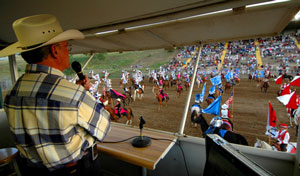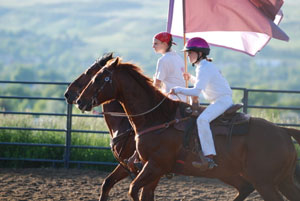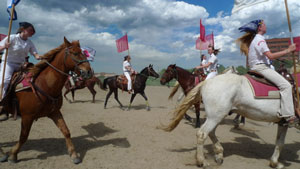Trouble reading this email? Read it online :: Recent Letters :: Clickertraining.com :: Clicker Gear Store ::  :: ::  |
Denver's Westernaires
My friends Leslie and John Hawkinson live in Golden, Colorado. They participate in a fifty-year-old riding organization called Westernaires. Leslie is an expert driver and traveled for years with the Coors beer eight-horse hitch of Belgians. For Westernaires, she has trained horses and ponies to pull carts and wagons and taught children and adults to drive them. John, an engineer, is a master at building and repairing wagons, stage coaches, and other rolling stock used in Westernaires competitions and performances. Their four children, now grown, were all Westernaires. My friends have always wanted me to see Westernaires, because from a training standpoint it's unique. Now I'm in Denver and I have time, and we go.
 (from grandstand) Four teams of Westernaires |
It's big. I knew that; I didn't know how big. Westernaires trains kids to ride—over 1500 kids a year. The fees? Just $35 a year for the insurance, and $15 a ride if you rent one of their 150 horses—nothing if you trailer in your own horse, as hundreds do.
The first lesson
We turn in the driveway. On our left are the turn-out paddocks for horses that have finished their sometimes eight-hour days. On our right, in one of three working arenas, a class is underway.
This is no ordinary riding ring, with eight or ten children neatly spaced and a riding teacher in the middle. In this ring fifty children on horseback are riding in pairs around the perimeter. Two adults are standing in the center. Another instructor is among the parents watching over the fence. Leslie tells me that these children, aged nine or ten, are having their very first riding class. She points out three older kids on horseback, junior instructors who are riding alongside one child and then another, teaching basics such as how to hold the reins.
The class ends. The children are now riding two by two in a long column back to an indoor arena where they will have their first lesson in tying up a horse, unsaddling, grooming, leading, and putting the horse away.
We follow them to the indoor arena. About fifty interested parents of all ages and types join us at one end of the space. A very small nine-year-old boy leads a large palomino to the rail in front of me; a brisk young woman shows him how to tie the horse up. The horse is restless, moving about and swinging his head at the boy, who dances out of reach. Not a beginner's horse, I would have said, but the kid doesn't care. When he learns how to undo the girth and swing the saddle down—it seems as big as the boy himself, as he can barely hold it off the ground—his face breaks into a thrilled grin. This is important, because Westernaires is not just about doing things right; Westernaires is also about thrills.
 Westernaires on parade in |
Making progress
In your first year, you learn to ride. Right from the beginning, you ride in formation, like cavalry. You're so busy keeping the horses two abreast or four, turning and stopping and starting in unison, that you forget to be afraid. Then you're put on a team, competing with other teams, riding in formation, first at a walk, then a trot, then a canter. By year two, you also have classroom work, learning to diagram the formations so that you can fill any slot in the drills you are practicing.
In year three, you can start "specialty" training. This includes liberty riding, bareback, with only a wire around the horse's neck for a bridle; Roman riding, where you stand with one foot on each of two horses; trick riding, as it's done in rodeos; "Riders of the Steppes," doing all the amazing acrobatics of the Cossacks, from picking up a fallen comrade to dismounting and remounting at a gallop; and driving, maybe two, three, or even four horses at once.
Imagine that you've chosen the liberty specialty, learning to ride bareback with no bridle. "Oh, they fall off all the time at first, " Leslie says, "but they get over it." Now imagine that you like it, and get a place in an advanced team. By fourteen or fifteen, you can do everything, including drill maneuvers and jumping, bareback at a full gallop.
Show time
Westernaires teams put on performances at national stock shows, big rodeos, and other public events. They have performed for presidents and political events, and with and for the Canadian Mounties. Everything is done in costume, with every rider carrying a large flag, and at full speed. And everyone, even the horses, seems to be having fun.
 Madison Hawkinson and a teammate practicing |
Safety is first; safety is mandatory. But safety means no running in the parking lot; no playing or roughhousing around the horses, ever; no dirty or dangling clothes, just a clean neat shirt and pants that won't catch on anything; no improperly saddled horses. Safety does NOT mean you can't learn to be the top girl or boy on the on-horseback three-layers-high human pyramid if that's what you'd like to do.
The volunteers
Every adult in this entire organization is a volunteer (the only person who gets paid is the night watchman). Where do the 200 or so instructors and helpers come from? They are parents and alumni, mostly. They go through two full years of training before they can take charge of the kids. A lot of the training is directed at positive teaching methods: no haranguing, scolding, belittling, or bullying. The students get the same respect they give the horses.
Where do the horses come from? They are throwaways and giveaways, at first. For example, Leslie was involved in collecting an abandoned herd of Shetland ponies, once owned by a dairy farm, turned loose on Table Mountain to do as they pleased for twenty years. They were pleased to multiply. By the time Westernaires rounded them up, there were over 40 ponies, all brown and white, and they trained them to drive in multiple pony hitches. Now those ponies have all passed on, but new horses continue to arrive. Many of the new horses are reclaimed wild mustangs, tamed and trained by Westernaire staff and kids, and much respected by all for their great stamina.
Star performers
The sun is setting. Leslie takes me to see one last class, one she herself taught for many years: the chariot driving. In a big indoor arena six Westernaires-built chariots are circling at a walk. The drivers are juniors and seniors in high school. The chariots are pulled by two, three, or four large ponies, smaller than horses but much bigger than Shetlands, hitched abreast. Some of the chariots have two drivers aboard, swapping the reins now and then as one driver coaches the other.
Music starts. At a trot, the chariots move together, circling and melding in drill formations. Beautiful. There's a break, while the instructor walks alongside and talks to each driver. The music starts again. Now they are "threading the needle," a formation in which two rows of horses and drivers come into the center from opposite ends of the arena and pass through the other line head-on—and they're doing this at a full gallop.
 Young riders practicing |
Now a chariot hurtles past us on the rail, four ponies side by side, straining forward with wide eyes and nostrils, running flat out. The driver, a girl of seventeen, is poised and balanced, her hands steady on the reins. The look on her face is so intense, and at the same time so exhilarated, that it makes tears come to my eyes.
Now a boy driving three ponies at a gallop goes around a corner sharply enough to slew the chariot sideways. "Boys," Leslie says. "You have to let them do that stuff." Then she remarks that sometimes the men who teach at Westernaires will pull that trick with a whole stagecoach.
After Westernaires
When you graduate from high school, it's over. By then, though you have learned a whole bunch of stuff besides how to pick up a handkerchief from the back of a galloping horse: self control, confidence, physical and mental discipline, cooperation, responsibility for others as well as yourself, and how to be an equal working partner with not just one, but many, horses. Not a bad investment for $35 a year. Besides, for the rest of your life, if you want to stay involved, Westernaires has room for a heck of a lot of volunteers.
Happy clicking,
Karen Pryor
Happy clicking,

Karen Pryor Clickertraining
49 River St., Suite 3
Waltham, MA 02453
1-800-47-CLICK(2-5425)
| Have you registered for ClickerExpo yet? Join us for an all-new, phenomenal training conference in Portland, Oregon, January 29-31, 2010 or Lexington, Kentucky, March 19-21, 2010! This season of ClickerExpo is the freshest, most exciting event yet. Learn more in three days than you ever thought possible. Check out the new program! And register soon!
|


